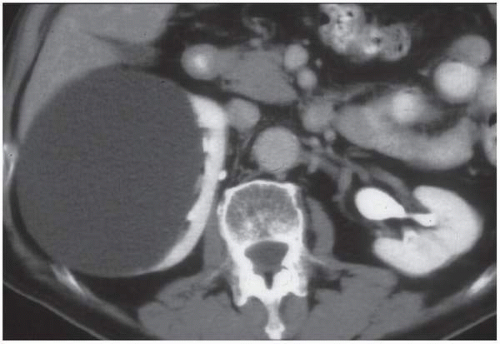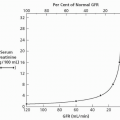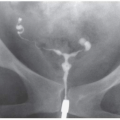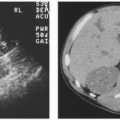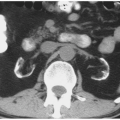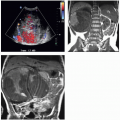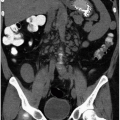Renal Cystic Disease
Renal cysts, cystic disease, and cystic masses are the most common abnormalities encountered in uroradiology. In some patients, renal cysts are part of a systemic process that also involves the kidneys. In most patients, however, one or several cystic masses are detected, and the radiologist must determine whether a particular cystic mass is benign or malignant. In most patients, the radiographic findings are sufficiently characteristic that further evaluation is not required. In some cases, however, an examination specifically designed to examine a renal mass may be necessary before a confident diagnosis can be reached.
CORTICAL CYSTS
Simple Cysts
The most common renal mass is a simple cortical cyst. Cortical cysts are uncommon in children or young adults but are detected routinely in the older population on computed tomography (CT), magnetic resonance imaging (MRI), and ultrasonography (US) examinations. In fact, renal cysts have been estimated to occur in 50% of the population older than 50 years of age. Thus, they are considered acquired lesions.
Simple cysts arise from the distal convoluted tubules or collecting ducts. The precise etiology of simple cysts is not known; it is proposed that they occur as a result of tubular obstruction such that the tubule no longer communicates with the nephron. They are composed of fibrous tissue and are lined by flattened cuboidal epithelium. They contain clear serous fluid and do not communicate with the collecting system.
Most patients with simple cysts are asymptomatic, and the cysts are detected as incidental findings. Hematuria is occasionally attributed to a benign cyst, but cysts bleed so infrequently that other lesions must be sought in patients with hematuria. Rarely, a large simple cyst may obstruct the collecting system or cause hypertension. Local pain may be attributed to distention of the cyst wall or spontaneous bleeding into the cyst; however, the vast majority of cysts are asymptomatic. Occasionally, a simple cyst may become infected.
Although simple cysts have been described in all age groups, they are unusual in children. A cyst in a child must be carefully examined to differentiate a benign cyst from a cystic Wilms tumor. A cyst in a child may also be an early sign of a cystic nephropathy.
A cortical cyst can occasionally be detected on an abdominal radiograph. The water-density cyst is seen as a cortical bulge projecting into the perinephric fat. Calcification is seen in the wall of a cyst in only approximately 1% of cases. If the calcification is thin and border forming, the lesion is likely to be a benign but complicated cyst.
Renal cysts are often detected as incidental findings during contrast-enhanced CT examinations of the abdomen, and there is no opportunity to test for contrast enhancement (Fig. 5.1). However, if the density of the cyst fluid is <20 HU and other criteria of a simple cyst are present, the lesion will almost certainly be benign.
The wall of a benign simple cortical cyst is often too thin to be seen on CT, but a pencil-thin, smooth wall may be seen. When evaluating wall thickness with CT, it is important to evaluate the portion of the cyst that extends well away from the parenchyma so that a portion of adjacent renal tissue (beak) is not included in the section. If the cyst is completely intrarenal, wall thickness cannot be assessed.
Simple cortical cysts are readily detected with MRI (Fig. 5.2). The appearance of a homogeneous round mass with a thin, smooth wall and sharp interface with normal renal parenchyma is similar to that on CT. The long T1 values result in a low signal intensity on T1-weighted images. However, they have a very high signal intensity on T2-weighted images, which reflects the long T2 value of water.
Corresponding features are also seen on ultrasound examinations. A simple cyst is a round homogeneous mass with a sharp interface with the normal renal parenchyma. A simple cyst is echofree with enhanced through transmission (Fig. 5.3). Thin septations that are too fine to be detected with CT may be seen with ultrasound.
Cysts may be seen with renal scintigraphy as photopenic regions because of the displacement of functioning parenchyma by the cyst. If the cyst is small or exophytic, scintigraphy may be normal. Parapelvic cysts, or cortical cysts that extend centrally into the renal sinus, may cause photopenic regions in the renal sinus that mimic hydronephrosis. The correct diagnosis is reached if the isotope can be identified in the ureter, even though the photopenic region persists.
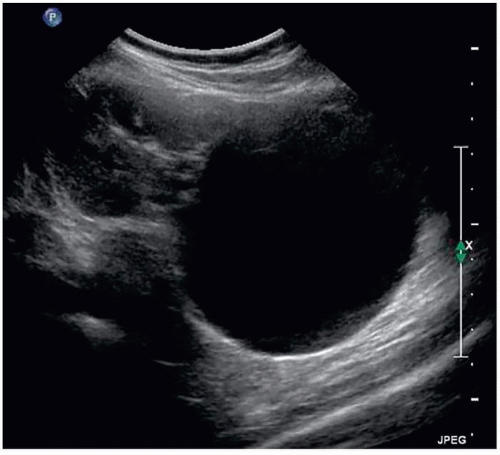 FIGURE 5.3. Large renal cyst. Ultrasound demonstrates an echo-free mass with enhanced through transmission. |
The accuracy of the radiographic diagnosis of a renal cyst depends on how well it is seen with each modality. When all of the criteria of a benign simple cyst are present, it is highly unlikely to be anything else and further evaluation is not warranted. Ultrasound is the most efficient method of diagnosing a simple cyst. Ultrasound is readily available, accurate, and relatively inexpensive. CT is the gold standard for the evaluation of renal masses, but it is a more expensive examination than ultrasound, requires intravenous contrast administration, and exposes the patient to ionizing radiation. It is indicated when an ultrasound examination is indeterminate or is technically inadequate due to the patient’s obesity or overlying bowel gas. MRI is used in patients with a contraindication to the use of intravenous contrast medium, or if after the CT scan, the nature of the cystic mass is still in question. Although typically more expensive and not as widely available, MRI may also be utilized in lieu of CT, particularly in young patients in whom the desire to reduce radiation exposure is greater.
Rarely, renal cysts may regress in size or disappear completely, often silently. Although this phenomenon may be caused by resorption of a hematoma misdiagnosed as a cyst, most cases are probably due to spontaneous cyst rupture. An increase in pressure within the cyst relative to the collecting system or the perinephric space may result in rupture. Such a pressure increase could be caused by hemorrhage into the cyst or by a change in the composition of the cystic fluid.
When symptomatic, the most common manifestations of cyst rupture are hematuria and flank pain. The diagnosis can be made by CT or MRI if the cyst communicates with the collecting system. In most cases, the communication of the cyst with the collecting system closes spontaneously. Once the diagnosis is made, management is conservative.
Unilateral Cystic Disease
Unilateral or localized renal cystic disease is characterized by replacement of all or a portion of one kidney by multiple cysts (Figs. 5.4 and 5.5). It is sometimes referred to as segmental cystic disease of the kidney. Although sometimes described as unilateral polycystic kidney disease, it is not familial. The disease is not progressive, and there is no association with renal failure or cysts in other organs. The pathogenesis is obscure, but it is hypothesized to be developmental in etiology. The most common clinical presentation is flank pain with or without hematuria.
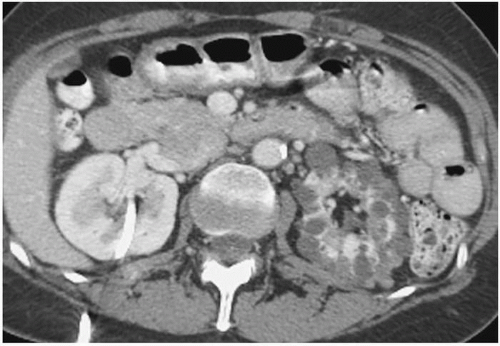 FIGURE 5.4. Unilateral cystic disease. An excretory phase CT image shows multiple left renal cysts and a normal right kidney. A right-sided percutaneous nephrostomy is present. |
Complicated Cysts
Cystic masses that do not satisfy the criteria of a benign simple cyst must be further evaluated to exclude malignancy. Various morphologic features are now recognized that exclude the diagnosis of a simple cyst.
Septations
Cysts may develop septations; when they are thin, smooth, do not have localized areas of thickening or irregularity, and are few in number, the lesions are generally considered benign, complicated cysts. These thin septations are more easily detected by ultrasound or MRI than CT. When a cystic mass contains one or more thick septations, a malignant lesion is possible. If there is associated nodularity, the lesion must be considered malignant.
Calcification
The presence of calcification is also a nonspecific finding (Fig. 5.6). When evaluation of the kidney depended primarily on excretory urography, the presence of calcification, especially central calcification, was an ominous sign. However, CT has made the presence or absence of calcification almost irrelevant because wall thickening and soft tissue masses can easily be detected without the help of calcification. Thin calcification in the wall or septum of a cyst is almost always benign and does not, in itself, warrant surgical exploration.
 FIGURE 5.6. Bosniak type II cyst. Thin straight septal calcifications are present in this cyst. This is of minimal concern for malignancy. |
Thick Wall
A thick wall is incompatible with a simple cyst. It indicates that the lesion is another cystic mass or that the cyst has become complicated by some process such as infection, hemorrhage, or neoplasia. Inflammatory or infectious cystic masses may result in a thickened wall, typically associated with abundant perinephric stranding. A thick-walled cystic renal mass may also be a cystic renal cell carcinoma (see Chapter 6). These lesions are generally considered indeterminate, and unless an inflammatory or infectious diagnosis can be made clinically or via percutaneous needle aspiration, closeinterval follow-up or surgical exploration is indicated (Fig. 5.7). The presence of a markedly thickened and irregular wall (Fig. 5.8) or an associated soft tissue tumor mass is an even more ominous finding and is highly suspicious for a malignancy.
Increased Density
A cystic mass with a density above water must contain more than simple cystic fluid. Cystic renal masses with an attenuation above 20 HU are worrisome and may be proteinaceous cysts, hemorrhagic cysts, or solid neoplasms, and further evaluation is warranted. One category of an atypical renal cyst that has an increased attenuation is the hyperdense cyst. These lesions look like typical simple cysts on CT examination in that they are round, well-marginated, homogeneous masses that do not enhance with intravenous contrast material administration. Hyperdense cysts are typically small, peripheral lesions, measuring 3 cm or less in diameter (Fig. 5.9A,B). Instead of displaying an attenuation of water, they typically measure 50 to 90 HU. Those that are denser than the renal parenchyma are easily recognized on unenhanced CT examinations, but they may be masked by enhanced renal parenchyma. Thus, these lesions are probably more common than is appreciated, as most abdominal CT scans are performed after intravenous contrast medium administration. Hyperdense masses that are intrarenal are more problematic; care must be used to differentiate such lesions from hyperdense solid tumors. Almost all renal masses with an unenhanced attenuation above 70 HU are benign, hyperdense cysts.
There are several possible etiologies for a hyperdense renal cyst. The most common etiologies are hemorrhage and a high-protein content of the cyst fluid. However, a diffuse, pastelike calcified material has also been found. Most of these hyperdense cysts are benign, but they must be carefully examined for other atypical features. CT examination before and after intravenous contrast medium administration is often helpful. A cyst will not enhance, whereas a solid tumor will.
US may be useful in the evaluation of a renal mass with an attenuation higher than water on CT. It may enable the examiner to distinguish between a cystic lesion and a solid lesion. With ultrasound, blood elements can sometimes be seen floating within the cyst. However, if the lesion cannot be clearly evaluated with US, CT, or MRI examinations, percutaneous biopsy or surgical exploration may be needed.
Hyperdense cysts can also be evaluated with MRI. Simple cysts have low signal intensity on T1-weighted images, whereas hyperdense cysts due to hemorrhage or high-protein content may have high signal intensity on all pulse sequences. Because blood elements tend to settle out, the more intense signal of the paramagnetic methemoglobin can be seen in the dependent portion of the cyst on T1-weighted images. The relative intensity of the two cyst layers may reverse on T2-weighted sequences. With time, hemorrhagic or proteinaceous cysts show low to intermediate signal on T1-weighted images and have similar appearance on T2-weighted images (Fig. 5.9C). A renal cell carcinoma can often be distinguished
by its heterogeneity, indistinct or irregular margins, lack of a fluid-hemoglobin level, or enhancement.
by its heterogeneity, indistinct or irregular margins, lack of a fluid-hemoglobin level, or enhancement.
Enhancement
The presence or absence of enhancement on CT or MRI after contrast medium administration is the single most important criterion for distinguishing benign cystic renal masses from vascular or solid lesions. Enhancement on MRI can be measured by determining the percentage change in signal intensity values of a renal mass after contrast material. Enhancement may be defined as an increase of 15% or greater. Subtraction MR imaging offers another method of determining whether enhancement is present in a cystic mass. With this method, unenhanced fat-saturated T1-weighted images are subtracted from T1-weighted gadolinium-enhanced images, and the corresponding images are displayed. Images must be obtained in the same phase of respiration to avoid misregistration artifacts. When there is no enhancement, the mass will display uniformly absent signal and appear black.
At CT, enhancement is determined by measuring the difference in attenuation of a mass or a region of a mass between the enhanced and unenhanced scans. If a region of a cystic mass enhances <10 H, it is considered nonenhancing. If a region enhances by 20 H or more, it is considered enhancing. If the difference is between 10 and 20, it is indeterminate and US or MRI may be used to determine if the mass is solid or cystic. With complex and heterogeneous lesions, multiple small attenuation measurements should be obtained while being certain that obvious sources of error like the renal sinus or perinephric fat are excluded from the measurement.
The term pseudoenhancement has been used to describe the spurious increase in enhancement after contrast medium administration. It is caused by the CT reconstruction algorithm that adjusts for beam-hardening effects. Pseudoenhancement is most pronounced with small (<1 cm), intrarenal lesions during the early phases of contrast enhancement when plasma contrast medium concentration is at its highest. When one is uncertain whether there is true enhancement or pseudoenhancement on CT, an alternate imaging modality such as US or MRI may be helpful.
Bosniak Classification
To clarify the need for further evaluation or treatment of complicated cystic lesions, Bosniak classified cystic renal masses into five categories.
Category I masses are cysts that fulfill all of the criteria for a benign, simple cyst (Fig. 5.1). No further evaluation is needed.
Category II masses are those with some atypical features but are reliably considered benign. Such features include few, thin, nonenhancing septa or thin, wall or septal calcifications (Fig. 5.6). Exophytic (at least a quarter of its circumference abutting fat) hyperdense cysts that fulfill all of the criteria described above are included in this category (Fig. 5.9).
Category IIF masses include a subset of patients with findings that are more worrisome. These lesions are considered Category IIF (“F” for follow-up). Such findings include more than a few thin septations with minimal, perceived enhancement (because the septa are too small to place a region of interest on them), or minimal wall or septal thickening (Fig. 5.10). Intrarenal or large (>3 cm) masses
that otherwise fulfill the criteria for a hyperdense cyst are placed in this category. Management recommendations include follow-up evaluation in 6 months and repeated at 1-year intervals to make sure the mass is not growing or, more importantly, not developing more worrisome morphologic features.
that otherwise fulfill the criteria for a hyperdense cyst are placed in this category. Management recommendations include follow-up evaluation in 6 months and repeated at 1-year intervals to make sure the mass is not growing or, more importantly, not developing more worrisome morphologic features.
Category III lesions cannot be distinguished from malignancies and generally require surgical exploration. The overall risk of malignancy is probably >50%. Features of masses in category III include one or more thick or irregular septations, some thickened walls, or large, non-border-forming calcifications (Figs. 5.7 and 5.11). There may be measurable enhancement present. Although some will be benign, these masses generally should be removed because no additional imaging can unequivocally prove that they are benign. Lesions in this category are often mimicked by hemorrhagic, inflammatory, or infected cysts. As a result, it is important to consider nonneoplastic etiologies of a renal mass lesion before applying the Bosniak classification, particularly when the clinical presentation suggests an infections etiology such as focal bacterial pyelonephritis and abscess. If an infectious etiology cannot be diagnosed on the basis of the imaging findings and clinical presentation, percutaneous needle aspiration should be considered. If an infectious etiology cannot be demonstrated, surgery may be required to reach a diagnosis. If the patient is a poor surgical risk, percutaneous biopsy may be used. However, the solid portions of these masses are often difficult to sample, and unless a benign entity can be diagnosed confidently by biopsy, negative results should be viewed with caution.
 FIGURE 5.11. Bosniak III cyst. Excretory phase image shows a cystic left renal mass with enhancing septa. Proven renal cell carcinoma. |
Category IV lesions have features that strongly suggest malignancy (Figs. 5.8 and 5.12). Although there may be a large cystic area, there is at least one enhancing nodule, particularly when it is apart from the wall. These are treated as presumed renal cell carcinomas.
The Bosniak classification is a useful method by which the level of concern about a particular lesion can be expressed. Category I and IV lesions can generally be assigned with a high level of agreement among observers. The difficulty is in the assignment of lesions to categories II, IIF, and III and the markedly different management this assignment entails. In addition, other factors such as the patient’s age and coexisting morbidity play a major role in how a lesion is managed. For example, a small cystic mass with a solid component may be followed in a patient with limited life expectancy or severe comorbidities, whereas it would be removed from otherwise healthy patients with similar imaging findings.
BOSNIAK CLASSIFICATION
Category I—uncomplicated simple cyst with no atypical features
Category II—minimally atypical features with little, if any, risk of malignancy
Category IIF—minimally concerning features requiring follow-up
Category III—indeterminate lesion with a significant concern for malignancy
Category IV—cystic appearing but frankly malignant features
Milk of Calcium Cyst
Milk of calcium is a collection of small calcific granules in the cystic fluid. The granules, usually calcium carbonate, are in suspension and layer out in the dependent portion of the cyst. They are seen most frequently in calyceal diverticula (see Chapter 12). Milk of calcium cysts have no sex predilection but are more common in the upper poles of the kidneys.
The milk of calcium nature of these calculi may not be appreciated on a supine radiograph, but the fluid calcium layer is easily detected on upright films or CT examinations (Fig. 5.13). A horizontal line of calcium density can also be detected using ultrasound, regardless of the patient’s position. Most of these cysts are detected as incidental findings, and intervention is unnecessary.
MEDULLARY CYSTIC DISEASE
This disease complex includes medullary cystic disease and juvenile nephronophthisis. Extrarenal manifestations such as retinal degeneration, hepatic fibrosis, and skeletal abnormalities are associated with the juvenile form. The kidneys are small to normal in size and maintain a normal configuration and smooth contour. A variable number of small cysts, up to 2 cm in diameter, are located primarily in the medulla. The cortex is thin but does not contain cysts. Biopsy shows interstitial and periglomerular fibrosis as well as tubular atrophy. However, the diagnosis cannot be made if cysts are not included in the biopsy specimen, because the fibrotic changes are nonspecific.
The uremic medullary cystic diseases can be classified by the age of onset. The adult form is transmitted by autosomal dominant inheritance. Patients usually present as young adults with anemia, which may be severe, and have progressive renal failure. These patients have a salt-wasting nephropathy that is not corrected with mineralocorticoids. Other than a fixed low-specific gravity, the urine sediment is normal. Hypertension may develop near the end of the disease course.
Patients with juvenile nephronophthisis typically present at 3 to 5 years of age with polydipsia and polyuria. The clinical course with anemia and progressive renal failure is similar to the adultonset variety, but progression is slower, with 8 to 10 years before terminal uremia. Juvenile nephronophthisis is transmitted by autosomal recessive inheritance.
Abdominal radiographs may demonstrate small kidneys without calcification. CT and MRI reveal a thin renal cortex. Linear contrast collections radiating from the renal pyramids may be seen. However, contrast medium-enhanced CT scans are not likely to be helpful and are seldom performed because of renal failure. Unenhanced CT or MRI demonstrates small, smooth kidneys and may reveal the small medullary cysts.
High-resolution ultrasound may be the examination of choice in these patients. The corticomedullary differentiation is lost, and the parenchyma appears isoechoic or hypoechoic with the liver or spleen. In patients with severe uremia, medullary cysts can usually be demonstrated, but they may not be detectable in milder cases. Examination with unenhanced MRI may be particularly useful when ultrasound is indeterminate. The problems with motion artifact due to breathing are decreased with fast spin echo breath-hold techniques.
POLYCYSTIC RENAL DISEASE
Stay updated, free articles. Join our Telegram channel

Full access? Get Clinical Tree


